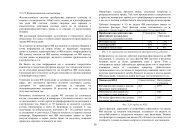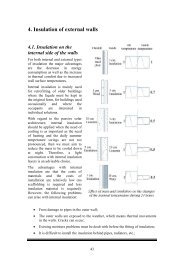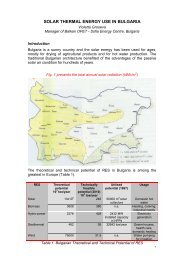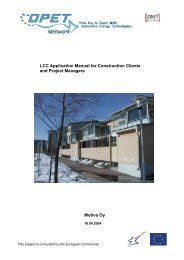Guidebook for Energy Efficiency in Municipalities
Guidebook for Energy Efficiency in Municipalities
Guidebook for Energy Efficiency in Municipalities
You also want an ePaper? Increase the reach of your titles
YUMPU automatically turns print PDFs into web optimized ePapers that Google loves.
air supply at the beg<strong>in</strong>n<strong>in</strong>g of each w<strong>in</strong>ter day, to warm-up the build<strong>in</strong>g at maximum<br />
efficiency.<br />
<strong>Energy</strong> distribution systems: Pumps circulat<strong>in</strong>g chilled or heated water, as well as fans<br />
blow<strong>in</strong>g air through ducts, often consume as much energy as is used to heat and cool the<br />
build<strong>in</strong>g. Furthermore, ducts and pipes are often <strong>in</strong>adequately <strong>in</strong>sulated, so much of the<br />
cool<strong>in</strong>g or heat<strong>in</strong>g energy may be wasted dur<strong>in</strong>g distribution. In large build<strong>in</strong>gs, both<br />
heat<strong>in</strong>g and cool<strong>in</strong>g systems often operate at the same time because of variations <strong>in</strong><br />
temperature throughout the build<strong>in</strong>g. This further <strong>in</strong>creases distribution energy losses.<br />
Control systems monitor the heat<strong>in</strong>g and cool<strong>in</strong>g requirements of the build<strong>in</strong>g and vary<br />
the operation of the HVAC system to ma<strong>in</strong>ta<strong>in</strong> com<strong>for</strong>t. At its most basic, a system may<br />
have a simple thermostat. Sophisticated systems <strong>in</strong>volve time controls, humidity sensors,<br />
CO 2 sensors and optimisation systems, and may be part of a complex Build<strong>in</strong>g<br />
Automation System (BAS). In large build<strong>in</strong>gs, control systems may operate heat<strong>in</strong>g and<br />
cool<strong>in</strong>g systems at the same time, <strong>in</strong> response to conditions <strong>in</strong> different parts of the<br />
build<strong>in</strong>g; these systems often work aga<strong>in</strong>st each other.<br />
Heat<strong>in</strong>g and/or cool<strong>in</strong>g equipment varies <strong>in</strong> scale and complexity from a simple wallmounted<br />
air-conditioner, through standard ‘packaged’ modular units, to large and<br />
complex systems with boilers to provide heat, and chillers and cool<strong>in</strong>g towers to provide<br />
cool<strong>in</strong>g. The more complex the system, the larger the energy losses from the associated<br />
equipment, such as fans and pumps, and from the distribution system will be.<br />
Ensure that the system is ma<strong>in</strong>ta<strong>in</strong>ed properly<br />
Even if the HVAC equipment <strong>in</strong> a build<strong>in</strong>g is properly commissioned after construction,<br />
per<strong>for</strong>mance deteriorates over time. Thorough ma<strong>in</strong>tenance programs can there<strong>for</strong>e br<strong>in</strong>g<br />
substantial, cost-effective sav<strong>in</strong>gs. Where ma<strong>in</strong>tenance is carried out under contract,<br />
make sure the contract is sufficiently detailed and supervision is adequate to ensure that<br />
ma<strong>in</strong>tenance is done properly.<br />
In smaller build<strong>in</strong>gs, ma<strong>in</strong>tenance activities might <strong>in</strong>clude:<br />
check<strong>in</strong>g thermostat sett<strong>in</strong>gs, calibration and correct operation, <strong>in</strong>clud<strong>in</strong>g sensors and<br />
controllers away from the plant room;<br />
check<strong>in</strong>g the sett<strong>in</strong>g of controls <strong>in</strong>clud<strong>in</strong>g time switches and selector switches;<br />
check<strong>in</strong>g the operation and sett<strong>in</strong>gs of economy cool<strong>in</strong>g dampers and controls;<br />
regular clean<strong>in</strong>g or replacement of filters <strong>in</strong> air-conditioners;<br />
check<strong>in</strong>g <strong>for</strong> leaks or deterioration <strong>in</strong> <strong>in</strong>sulation of duct<strong>in</strong>g;<br />
seal<strong>in</strong>g of air leaks around doors and w<strong>in</strong>dows.<br />
Optimise the operation of pumps and fans<br />
Large sav<strong>in</strong>gs can be achieved by <strong>in</strong>stall<strong>in</strong>g variable-speed motor drives, so pump and<br />
fan speeds can be matched to requirements. The sav<strong>in</strong>gs are disproportionately large:<br />
halv<strong>in</strong>g the flow rate <strong>in</strong> moderate weather theoretically cuts pump or fan energy<br />
requirements to one-eighth.<br />
Further sav<strong>in</strong>gs can be achieved by:<br />
clean<strong>in</strong>g filters, fans and dampers regularly;<br />
check<strong>in</strong>g and lubricat<strong>in</strong>g or replac<strong>in</strong>g bear<strong>in</strong>gs;<br />
ensur<strong>in</strong>g that drive belts are <strong>in</strong> good condition, evenly matched and correctly adjusted;<br />
<strong>in</strong>stall<strong>in</strong>g high-efficiency, appropriately sized motors when replacement is needed,<br />
and <strong>in</strong>stall<strong>in</strong>g variable-speed drives where loads on motors vary;<br />
fitt<strong>in</strong>g time switches or more sophisticated controls and us<strong>in</strong>g them to shut down<br />
cool<strong>in</strong>g/heat<strong>in</strong>g <strong>in</strong> areas and at times when it is not needed.






